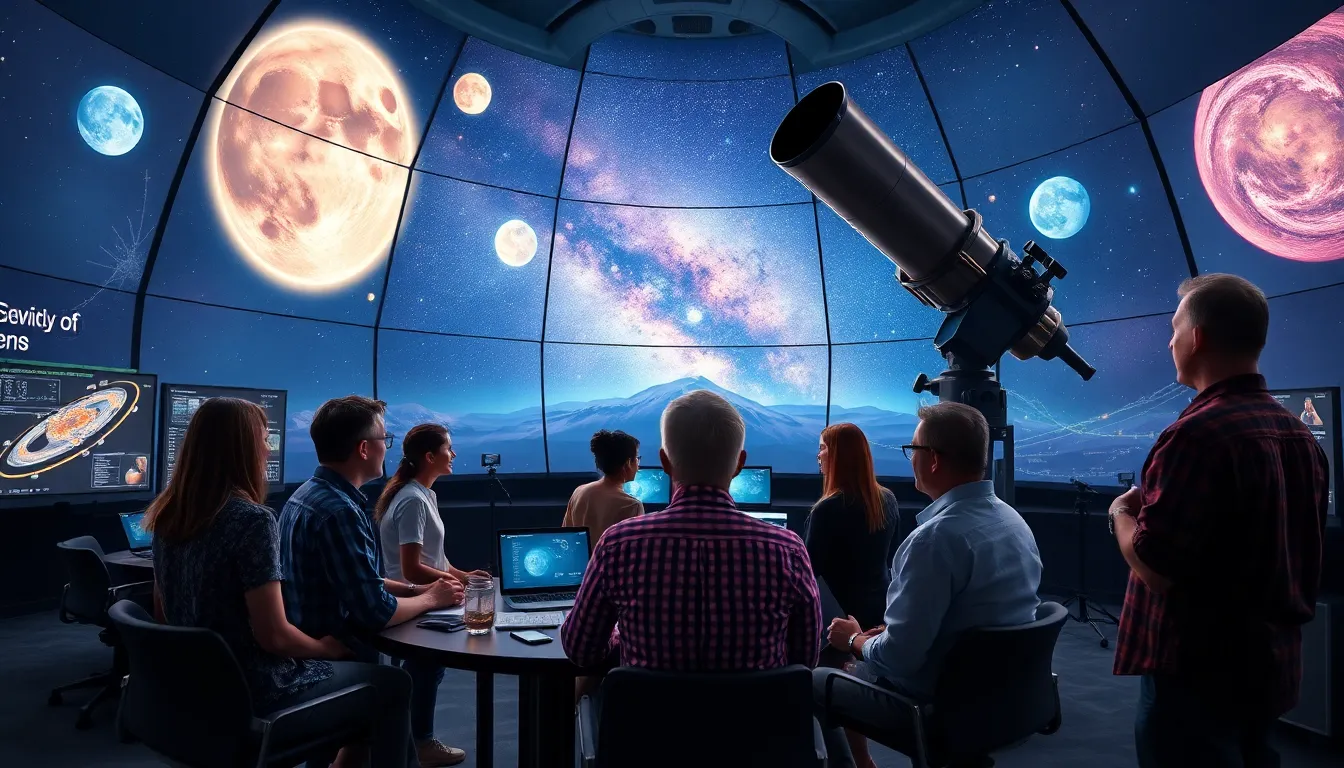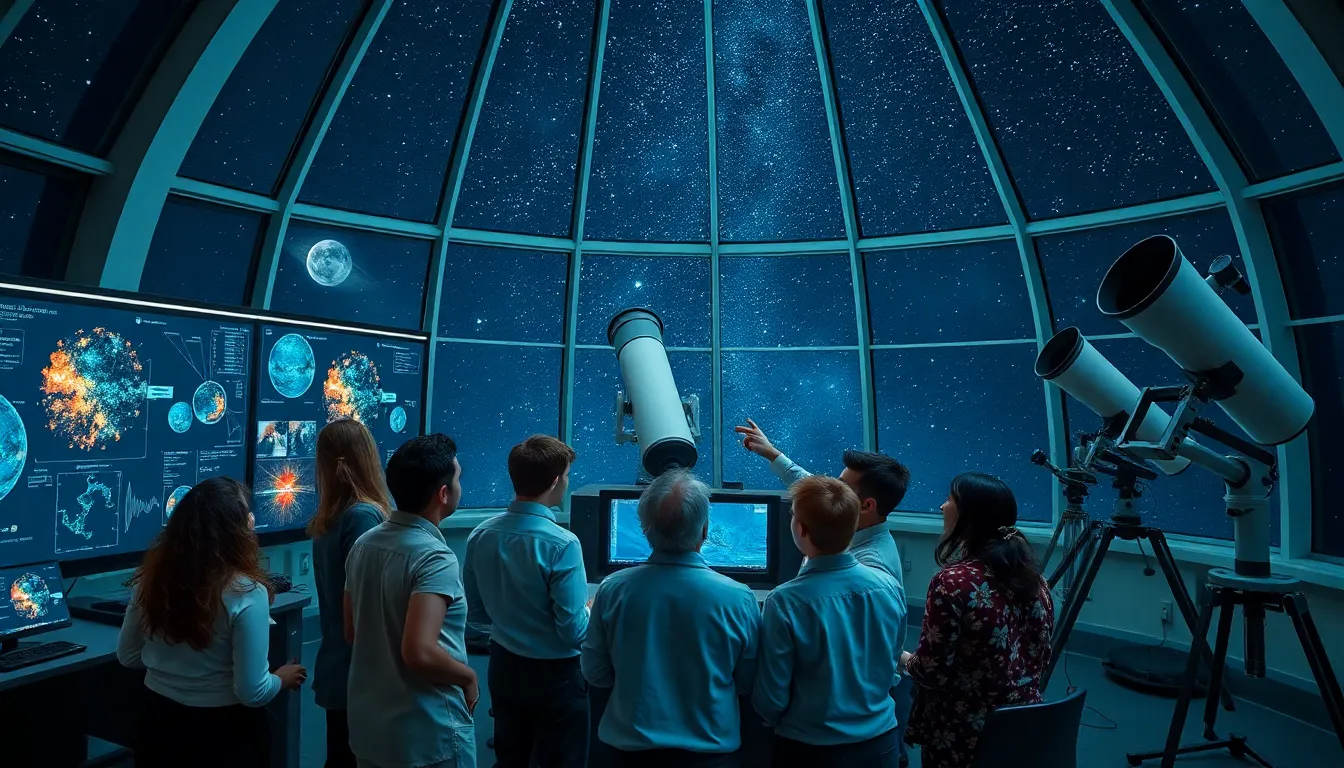In a universe overflowing with data, astroinformatics is the superhero we didn’t know we needed. Imagine sifting through galaxies of information faster than a speeding comet—this field combines astronomy with cutting-edge computing to unlock cosmic secrets. It’s like having a telescope that not only sees stars but also tells you their life stories.
Table of Contents
ToggleOverview of Astroinformatics Advancements
Astroinformatics is evolving rapidly, merging sophisticated computational tools with the vast datasets generated by modern astronomy. Significant progress in artificial intelligence and machine learning has enhanced predictive modeling, enabling researchers to identify celestial events more accurately. Advances in data visualization techniques provide clearer insights into complex astronomical phenomena, allowing scientists to comprehend intricate relationships between objects in space.
Open-source software platforms have emerged, facilitating collaboration among astronomers and data scientists. These platforms streamline data sharing and analysis, promoting innovation within the field. High-performance computing resources play a crucial role, handling the immense volumes of data collected by telescopes and space missions efficiently.
Cloud computing solutions also contribute significantly to astroinformatics by offering scalable resources for data storage and processing. These solutions allow astronomers to access and analyze data remotely, increasing flexibility in research methodologies. Improved algorithms for data mining further enhance exploration capabilities, uncovering new patterns and correlations in astronomical datasets.
Research initiatives are increasingly emphasizing interdisciplinary approaches, fostering partnerships between astronomers, computer scientists, and statisticians. Such collaborations lead to the development of new tools and methodologies, expanding the boundaries of current knowledge. Astroinformatics not only enhances understanding of the universe but also drives advancements in related fields, such as robotics and AI technology.
Overall, ongoing advancements in astroinformatics pave the way for groundbreaking discoveries, solidifying its pivotal role in the future of astronomical research.
Key Technologies Driving Progress


Astroinformatics thrives on several key technologies that propel research and discoveries in astronomy. These advancements enhance the efficiency and effectiveness of data analysis.
Big Data and Machine Learning
Big data analytics plays a vital role in astroinformatics, allowing researchers to process enormous datasets generated by telescopes and satellites. Machine learning algorithms identify patterns and make predictions about celestial events from these complex datasets. They enhance object classification, helping astronomers distinguish between different celestial bodies. With access to vast amounts of information, astronomers can refine their models, which leads to more accurate interpretations of astronomical phenomena. Data-driven insights contribute significantly to understanding cosmic events, enriching the way scientists engage with the universe.
Cloud Computing in Astronomy
Cloud computing provides scalable solutions crucial for managing large volumes of astronomical data. This technology enables astronomers to access high-performance computing resources without the need for extensive local infrastructure. Cloud platforms facilitate collaboration among researchers worldwide, allowing them to share resources and data seamlessly. Remote access to computing power accelerates the analysis of time-sensitive data, such as transitory astronomical events. By leveraging cloud capabilities, the astronomical community increases its potential to create new models and interpretations, pushing the boundaries of research further into the cosmos.
Applications of Astroinformatics
Astroinformatics plays a significant role in various applications within astronomy. Its capabilities enhance accuracy and efficiency in multiple domains.
Data Analysis in Astronomy Research
Data analysis transforms how researchers approach astronomical inquiries. Scientists utilize machine learning algorithms to analyze massive datasets, identifying patterns and anomalies in celestial phenomena. Big data technologies enable processing of petabytes of information from telescopes and spacecraft. The ability to quickly analyze this data leads to timely discoveries, particularly in transient astrophysical events. Advanced visualization tools also present complex data intuitively, aiding researchers in deriving meaningful insights from their findings.
Citizen Science Projects
Citizen science projects increasingly benefit from astroinformatics advancements. Engaging the public allows amateur astronomers to contribute to significant research efforts. Platforms enable volunteers to classify astronomical objects and report transient events, enriching datasets. These projects leverage cloud computing to provide tools and resources accessible to non-professionals. Increased collaboration fosters a sense of community and accelerates data collection, deriving insights from collective efforts. Overall, citizen science initiatives are essential in expanding the scope of astronomical research.
Recent Breakthroughs in the Field
Astroinformatics has made significant strides recently, particularly in technology and data analysis techniques.
Innovations in Telescope Technology
Advanced telescopes now incorporate sophisticated imaging systems that improve data collection. These systems enable astronomers to capture clearer images of distant celestial bodies. Noteworthy developments include adaptive optics, which correct atmospheric distortions in real-time. New multi-wavelength capabilities allow simultaneous observations across different spectrum ranges. Researchers also benefit from enhanced sensors that increase detection sensitivity, making it possible to identify fainter objects. Improved automation in telescope operations boosts observational efficiency, enabling longer exposure times. Instruments such as the James Webb Space Telescope exemplify these advancements, opening new frontiers in understanding the universe.
Enhanced Data Visualization Techniques
Data visualization techniques have evolved, significantly aiding in the analysis of complex astronomical data. New software tools allow for real-time, multi-dimensional visualization of datasets. Astronomers now utilize 3D rendering to depict celestial phenomena, providing deeper insights into structures like galaxies. Interactive visualizations enable users to manipulate data and explore outcomes dynamically. Advanced graphics techniques enhance the clarity of the presented information, facilitating quicker interpretations. These innovations help in identifying patterns that were previously difficult to discern. By employing virtual reality technologies, scientists can immerse themselves in data, leading to novel discoveries and a better understanding of celestial events.
Future Directions and Challenges
Astroinformatics faces several opportunities and challenges that will shape its future. Researchers increasingly rely on artificial intelligence and machine learning to analyze astronomical data. Integrating these advanced technologies presents difficulties, particularly in developing algorithms that adapt to both evolving datasets and the unique characteristics of celestial phenomena.
Scalable solutions delivered through cloud computing empower astronomers to conduct collaborative research. However, ensuring data security and managing costs remain significant challenges in this growing field. Effective collaboration among scientists and data specialists leads to innovative solutions, yet it is essential to establish standard protocols for data sharing.
As big data continues to expand, researchers must find efficient methods to process and interpret information. Augmenting processing power necessitates the development of new architectures that can handle vast datasets, which poses a technical challenge for many institutions. Furthermore, real-time data analysis from multiple observatories requires enhanced synchronization and integration capabilities.
Visualizing complex astronomical data contributes to discovery, but creating intuitive tools also presents hurdles. The demand for advanced visualization techniques necessitates investment in software development, emphasizing user experience alongside utility. As new technologies arise, researchers will need to train users in effectively utilizing these tools.
Engaging the public through citizen science projects fosters collaboration and enriches astronomical datasets. Coordinating these efforts remains a challenge due to varying levels of expertise and available resources. Fostering education and outreach will help bridge the gap between professional astronomers and amateur enthusiasts.
Ultimately, navigating the future landscape of astroinformatics requires addressing these challenges while leveraging existing advancements. Researchers, institutions, and communities must work together to refine processes and maximize the potential for groundbreaking discoveries in the field of astronomy.




